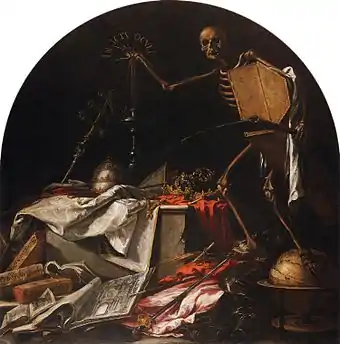In ictu oculi
The phrase in ictu oculi is a Latin expression meaning "in the blink of an eye". One source is from the Bible, in 1 Corinthians 15:52: "In momento, in ictu oculi, in novissima tuba", translated in the KJV as "In a moment, in the twinkling of an eye, at the last trump:"[1] where the Latin is itself a translation of the original Koine Greek phrase ἐν ῥιπῇ ὀφθαλμοῦ (en rhipēi ophthalmou).[2] The phrase was used by Henry of Huntingdon on the rapid submission to the coronation of Stephen of England in 1135: Sine mora, sine labore, quasi in ictu oculi.[3][4] It also appears as part of the text to a motet by Antoine Busnois entitled "Gaude celestis Domina".[5]

The most notable use of the phrase in an English text is that by John Donne: which shall be found alive upon the earth, we say there shall be a sudden death, and a sudden resurrection; In raptu, in transitu, in ictu oculi, where Donne gives an English-Latin paraphrase on the original context in 1 Corinthians 15.[6][7]
Works of art
More than the original context of the phrase itself, the Latin may be better known as the title of a painting by Juan de Valdés Leal (4 May 1622 – 1690). This painting, an allegory of death (c.1671), is one of two large still life[8] allegorical vanitas paintings, 2.2 metres (7 ft 3 in) high, by Valdés Leal, painted for the Charity Hospital of Seville.[9] The central character is a skeleton; on the floor lies an open coffin and symbols of wealth and power.[10] The skeleton extinguishes a candle which represents life, and above the taper is written the Latin motto.[11][12] A volume of Rubens' designs for Antwerp's triumphal arches for the 1634 reception of the new Spanish governor, Cardinal-Infante Ferdinand, stands as a symbol of political disillusionment.[13] The other painting of the pair is Finis Gloriae Mundi, "End of worldly glory," which depicts a dead bishop and a knight.[14]
The painting is a reflection of the vanitas concept in Spanish music of the same period, as illustrated in in ictu oculi. Música española del siglo XVII, a recording by the Spanish early music ensemble Los Músicos de Su Alteza in 2002.[15] The name has also been used for a painting by Diango Hernandez (born 1970) in 2004.[16]
References
- 1 Cor. 15:52, King James Version. Bible Gateway.
- 1 Cor. 15:52, SBL Greek New Testament. Bible Gateway.
- Roger, of Hoveden; Stubbs, William (1868). Chronica magistri Rogeri de Houedene Roger (of Hoveden). London: Longman. p. 256. OCLC 1925703.
Hoc vero signum malum fuit, quod tarn reponte omnis Anglia sine mora, sine labore, quasi in ictu oculi ei subjecta est.
- Chartrou-Charbonnel, Josèphe (1928). L'Anjou de 1109 à 1151: Foulque de Jérusalem et Geoffroi Plantegenêt. Paris: Presses universitaires de France. OCLC 489975802.
Henri de Huntingdon ... indique que l'Angleterre se soumit très rapidement « sine mora, sine labore, quasi in ictu oculi ».
- ""The Ambassadors", Texts and English Translations" (PDF). The Orlando Consort. p. 1. Retrieved 2012-05-26.
- Donne, John; Potter, George R.; Simpson, Evelyn M. (1984) [1953]. The Sermons of John Donne. 2. University of California Press. p. 73.
- Donne, John; Alford, Henry (1839). The Works of John Donne: With a Memoir of His Life. London: Parker. p. 336.
- Harris, Ann Sutherland (2005). Seventeenth-Century Art & Architecture. Upper Saddle River, N.J.: Pearson Prentice Hall. p. 240. ISBN 978-0-131-45577-1.
Valdes Leal's canvases are still-lives but on such a large scale – more than 7 feet (2.1 meters) high – that they transcend that genre to become religious paintings. The skeleton in one canvas – In Ictu Oculi – is the sole actor amid ...
- Myers, Shirley D.; Myers, Bernard Samuel, eds. (1979). Encyclopedia of painting. New York: Crown Publishers. ISBN 978-0-517-53880-7.
Contrary to this, of course, is the tighter technique of the allegories, Finis Gloriae Mundi and In Ictu Oculi, painted for the Charity Hospital of Seville, where Murillo (see) was also at work. These pictorial horrors exemplify the ...
- Radcliffe, Alida Graveraet (1909). Schools and Masters of Painting. New York: D. Appleton and Company. OCLC 12879829.
Round the flame of the taper are the words, 'in ictu oculi.' On the floor is an open coffin, ...
- Hartley, Catherine Gasquoine (1904). A Record of Spanish Painting. London: Walter Scott Publishing Company. OCLC 1114969.
Circling the gleaming light of the taper are the words "In Ictu Oculi," while an open coffin rests upon the ground, ...
- Perry, Mary Elizabeth (1990). Gender and disorder in early modern Seville. Princeton, N.J.: Princeton University Press. p. 164. ISBN 978-0-691-00854-7.
In Ictu Oculi (fig. 16), by the same artist, presents death as a skeleton standing over symbols of wealth and power and extinguishing a candle that symbolizes life.
- González de León, Fernando (2009). The road to Rocroi: class, culture and command in the Spanish Army. Leiden-Boston, The Netherlands: Brill. p. 345. ISBN 978-9-004-17082-7.
... chilling canvas In Ictu Oculi (1671) in which a volume of Rubens' designs for the Cardinal-Infante's triumphal arches stands as a symbol of political disillusionment, ...
- Symington, Andy (2004). Andalucía. Bath: Footprint. p. 79. ISBN 978-1-906-09851-3.
The inscription In Ictu Oculi translates as 'in the blink of an eye'. Opposite this is an even more challenging painting entitled Finis Gloriae Mundi ('the end of wordly glory'). It depicts a crypt in which a dead bishop and knight are ...
- "Website of group Los Mvsicos de Sv Alteza in Spanish". Losmusicosdesualteza.com. Retrieved 2013-12-19.
- "Diango Hernandez CV, Biography". Retrieved 2012-05-06.